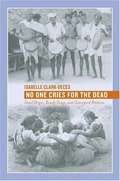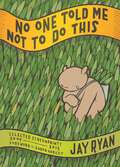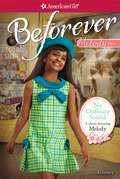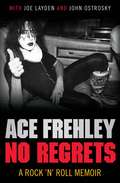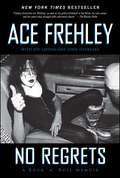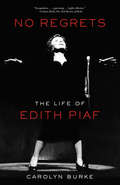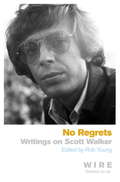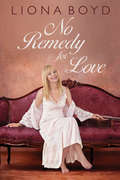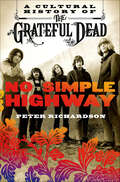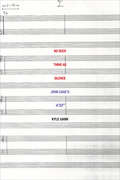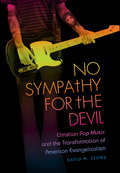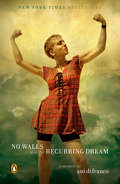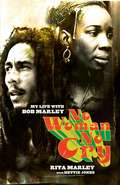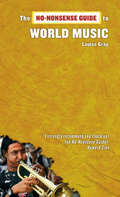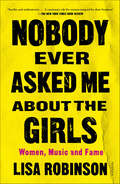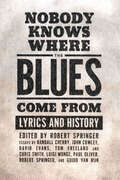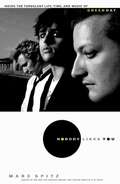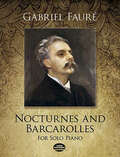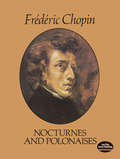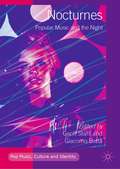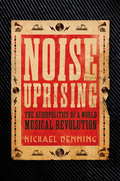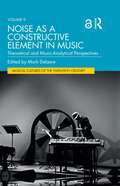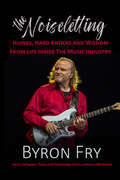- Table View
- List View
No One Cries for the Dead: Tamil Dirges, Rowdy Songs, and Graveyard Petitions
by Isabelle Clark-DecèsAt South Indian village funerals, women cry and lament, men drink and laugh, and untouchables sing and joke to the beat of their drums. No One Cries for the Dead offers an original interpretation of these behaviors, which seem almost unrelated to the dead and to the funeral event. Isabelle Clark-Dece's demonstrates that rather than mourn the dead, these Tamil funeral songs first and foremost give meaning to the caste, gender, and personal experiences of the performers.
No One Told Me Not to Do This: Selected Screenprints, 2009-2015
by Jay RyanOne of Indie Rock's Best Poster Artists (Pitchfork)"Ryan has been making strange little creatures since the mid-’90s, most often for bands in the Chicago area looking to promote concerts with something splashier than a Xeroxed flyer. His work is unmistakable: Whether it’s a bunch of animals cozied up under the covers or a smashed-up satellite advertising a Hum reunion, there’s nothing else exactly like it (and nothing nearly as charming)."--The A.V. Club, staff pick"Whether his subjects are whales, bears, mastodons, astronauts, dinosaurs, or his dilapidated garage, they’re rendered in warm colors, bold lines, and an instantly recognizable, beguiling and cartoonish style. If you lack sufficient wall space for another dozen of Ryan’s posters, get this."--The Big Takeover"The third collection of Ryan’s screen-printed work, covering 2009-2015, includes more than 50 band posters (Andrew Bird, Sonic Youth, St. Vincent) plus several festival posters."-- Publishers Weekly"A new select collection of recent poster and commercial work of artist Jay Ryan - someone whose crazy skills really do put the GREAT in 'greatest hits.’ It's rock poster art, alt-movie poster art and more."--Atomic Books Comic Preview, Largehearted Boy"[The book] features Ryan’s colorful and distinctive artwork, most of which are concert posters, including those for shows by queer artists including Bob Mould and St. Vincent."-- Living Out LI"An exceptional guide to not just Jay Ryan's art, but to the process involved in making superior screenprints."--Donovan's Literary Services, a Prime PickThis third collection of Ryan's "greatest hits" features prints made between 2009 and 2015, including posters for bands such as Andrew Bird, Shellac, My Morning Jacket, Sonic Youth, Dinosaur Jr., Hum, St. Vincent, and others, as well as posters featuring Lil BUB, Cards Against Humanity, various bicycle races, film screenings, and pictures of sloths, walruses, and other mammals in states of troubled sleep. With a foreword by master illustrator Aaron Horkey, this volume comprises two hundred screenprints with commentary and original drawings used in the screenprinting process.
No Ordinary Sound: A Melody Classic (Beforever #Volume 1)
by Denise Lewis PatrickMelody is an optimistic, enthusiastic girl growing up in Detroit, Michigan during the Civil Rights Movement of the 1960s. She is excited and proud to share a special surprise with her family. She's been chosen to sing a solo for Youth Day at her church! But what song will she choose? She gets advice from her big brother, and is also inspired by her older sister, but it's the inspirational words of Dr. Martin Luther King Jr. that help her pick the perfect song. There are many unfair things happening during Melody's time, even to people in her own family. But it's an unimaginable tragedy in the South that leaves Melody silent. Who can help her lift her voice and sing? Who will inspire her to keep stepping?
No Regrets
by Joe Layden Ace FrehleyBorn into a regular Bronx family, and inspired by the likes of Hendrix, Led Zepellin, and the Kinks, Ace Frehley first picked up his brother's guitar at the age of 12. He had already performed in a number of bands when, in January 1973, he auditioned for an ad that read: "Guitarist wanted with flash and balls. " Within a week he was invited to join - the band was KISS. Frehley explains how the band developed their style in the early days, making their own clothes, wearing make-up and platform shoes. Ace himself even designed the band's double lightning bolt logo. Before long his persona "the Spaceman" was born and the familiar KISS look established - almost overnight they left behind 1,500 seater theatres in the Midwest and were playing sold-out stadiums around the world. Life in KISS was a whirlwind of accidents, overdoses and excess. Ace partied with the likes of John Belushi and Nic Nolte and enjoyed the seemingly endless supply of fringe benefits that came from being in one of the most successful bands in the history of rock 'n' roll. But soon problems with substance abuse would lead to his leaving the band in 1982, before returning for a second tenure in 1996. Ace in the Hole is the story of KISS but much more than that - it's the story of a kid from the Bronx who found purpose and salvation through music and rose to the top. It's the story of a guy who lived life to the fullest and almost forfeited his life as a result. And ultimately it's a survival story - Ace is alive and kicking, still making music and influencing a new generation of guitarists.
No Regrets: A Rock 'n' Roll Memoir
by Joe Layden Ace Frehley John OstroskyTHE MUSIC, THE MAKEUP, THE MADNESS, AND MORE. . . . In December of 1972, a pair of musicians placed an advertisement in the Village Voice: “GUITARIST WANTED WITH FLASH AND ABILITY.” Ace Frehley figured he had both, so he answered the ad. The rest is rock ’n’ roll history.He was just a boy from the Bronx with stars in his eyes. But when he picked up his guitar and painted stars on his face, Ace Frehley transformed into “The Spaceman”—and helped turn KISS into one of the top-selling bands in the world. Now, for the first time, the beloved rock icon reveals his side of the story with no-holds-barred honesty . . . and no regrets.For KISS fans, Ace offers a rare behind-the-makeup look at the band’s legendary origins, including the lightning-bolt logo he designed and the outfits his mother sewed. He talks about the unspoken division within the band—he and Peter Criss versus Paul Stanley and Gene Simmons—because the other two didn’t “party every day.” Ace also reveals the inside story behind his turbulent breakup with KISS, their triumphant reunion a decade later, and his smash solo career. Along the way, he shares wild stories about dancing at Studio 54 with “The Bionic Woman,” working as a roadie for Jimi Hendrix, and bar-flying all night with John Belushi. In the end, he comes to terms with his highly publicized descent into alcohol, drugs, and self-destruction—ultimately managing to conquer his demons and come out on top. This is Ace Frehley.No makeup.No apologies.No regrets.
No Regrets: The Life of Edith Piaf
by Carolyn Burke"Sympathetic . . . captivating . . . highly effective." --Graham Robb, New York Review of Books "Concise and gracefully written. . . . Burke surveys all [Piaf's] mayhem with thoughtfulness and respect." --James Gavin, New York Times Book Review The iconic French singer comes to life in this enthralling, definitive biography, which captures Edith Piaf's immense charisma along with the time and place that gave rise to her unprecedented international career. Raised by turns in a brothel, a circus caravan, and a working-class Parisian neighborhood, Piaf began singing on the city's streets, where she was discovered by a Champs-Elysees cabaret owner. She became a star almost overnight, seducing Paris's elite and the people of its slums in equal measure with her powerful, passionate voice. No Regrets explores her rise to fame and notoriety, her tumultuous love affairs, and her struggles with drugs, alcohol, and illness, while also drawing on new sources to enhance our knowledge of little-known aspects of her life. Burke demonstrates how, with her courage, her incomparable art, and her universal appeal, "the little sparrow" endures as a symbol of France and a source of inspiration to entertainers worldwide. Carolyn Burke is the author of Lee Miller: A Life and Becoming Modern: The Life of Mina Loy. She has taught at the University of California at Santa Cruz and Davis and at universities in France and Australia, where she was born. She now lives in California.
No Regrets: Writings on Scott Walker
by Rob YoungA colourful collection of pieces on the enigmatic genius of Scott Walker from THE WIRE.Scott Walker has travelled from teen idol to the outer limits of music. From 'The Sun Ain't Gonna Shine Any More' reaching No.1, through to recordings of meat being punched on his last album, THE DRIFT, he somehow seems to have reached a passionate and committed fan base. Throughout his career, his impeccable critical reputation as a serious and uncompromising musician has never been questioned. The recent film, 30TH CENTURY MAN, had a litany of stars queuing up to praise Walker: the likes of David Bowie, Damon Albarn, Jarvis Cocker, Radiohead, Johnny Marr and Sting. But despite this, in 40 years of music, there has yet to be a serious book on Scott Walker. This collection, put together by Rob Young of THE WIRE magazine, features a handful of previously published articles and newly commissioned pieces, largely drawn from the orbit of THE WIRE's writers including Ian Penman, Chris Bohn and Rob Young.
No Regrets: Writings on Scott Walker
by Rob YoungA colourful collection of pieces on the enigmatic genius of Scott Walker from THE WIRE.Scott Walker has travelled from teen idol to the outer limits of music. From 'The Sun Ain't Gonna Shine Any More' reaching No.1, through to recordings of meat being punched on his last album, THE DRIFT, he somehow seems to have reached a passionate and committed fan base. Throughout his career, his impeccable critical reputation as a serious and uncompromising musician has never been questioned. The recent film, 30TH CENTURY MAN, had a litany of stars queuing up to praise Walker: the likes of David Bowie, Damon Albarn, Jarvis Cocker, Radiohead, Johnny Marr and Sting. But despite this, in 40 years of music, there has yet to be a serious book on Scott Walker. This collection, put together by Rob Young of THE WIRE magazine, features a handful of previously published articles and newly commissioned pieces, largely drawn from the orbit of THE WIRE's writers including Ian Penman, Chris Bohn and Rob Young.
No Remedy for Love
by Liona BoydA new memoir from internationally renowned musician Liona Boyd. Few people’s lives are as romantic and adventurous as Liona Boyd’s has been. She has performed around the world, sold millions of albums, won five Juno awards, serenaded numerous heads of state, and, for eight years, dated Prime Minister Pierre Trudeau. Continuing her story in a new memoir, Liona recounts how she lost her ability to perform, details her divorce, and chronicles the emotional roller-coaster ride that followed. After six years of searching for answers, reinventing her technique, and learning to sing, she returned to Canada and a new career, creating five new albums as a singer, songwriter, and guitarist. Liona shares the joys of composing and recording her own music and her cast of international friends, who include singer and actress Olivia Newton-John and her friend and pen pal of over thirty years, HRH Prince Philip. Liona reveals her love affairs, spiritual journeys, personal and musical struggles, and greatest triumphs. Writing with candour and passion, she gives a behind-the-scenes tour of her fascinating world.
No Simple Highway: A Cultural History of the Grateful Dead
by Peter RichardsonFor almost three decades, the Grateful Dead was America's most popular touring band. No Simple Highway is the first book to ask the simple question of why—and attempt to answer it. Drawing on new research, interviews, and a fresh supply of material from the Grateful Dead archives, author Peter Richardson vividly recounts the Dead's colorful history, adding new insight into everything from the Acid Tests to the band's formation of their own record label to their massive late career success, while probing the riddle of the Dead's vast and durable appeal. Arguing that the band successfully tapped three powerful utopian ideals—for ecstasy, mobility, and community—it also shows how the Dead's lived experience with these ideals struck deep chords with two generations of American youth and continues today.Routinely caricatured by the mainstream media, the Grateful Dead are often portrayed as grizzled hippy throwbacks with a cult following of burned-out stoners. No Simple Highway corrects that impression, revealing them to be one of the most popular, versatile, and resilient music ensembles in the second half of the twentieth century. The band's history has been well-documented by insiders, but its unique and sustained appeal has yet to be explored fully. At last, this legendary American musical institution is given the serious and entertaining examination it richly deserves.
No Such Thing as Silence
by Kyle GannFirst performed at the midpoint of the twentieth century, John Cage's 4'33", a composition conceived of without a single musical note, is among the most celebrated and ballyhooed cultural gestures in the history of modern music. A meditation on the act of listening and the nature of performance, Cage's controversial piece became the iconic statement of the meaning of silence in art and is a landmark work of American music. In this book, Kyle Gann, one of the nation's leading music critics, explains 4'33" as a unique moment in American culture and musical composition. Finding resemblances and resonances of4'33"in artworks as wide-ranging as the paintings of the Hudson River School and the music of John Lennon and Yoko Ono, he provides much-needed cultural context for this fundamentally challenging and often misunderstood piece. Gann also explores Cage's craft, describing in illuminating detail the musical, philosophical, and even environmental influences that informed this groundbreaking piece of music. Having performed 4'33" himself and as a composer in his own right, Gann offers the reader both an expert's analysis and a highly personal interpretation of Cage's most divisive work.
No Sympathy for the Devil: Christian Pop Music and the Transformation of American Evangelicalism
by David W. StoweIn this cultural history of evangelical Christianity and popular music, David Stowe demonstrates how mainstream rock of the 1960s and 1970s has influenced conservative evangelical Christianity through the development of Christian pop music. For an earlier generation, the idea of combining conservative Christianity with rock--and its connotations of nonreligious, if not anti-religious, attitudes--may have seemed impossible. Today, however, Christian rock and pop comprises the music of worship for millions of Christians in the United States, with recordings outselling classical, jazz, and New Age music combined. Shining a light on many of the artists and businesspeople key to the development of Christian rock, Stowe shows how evangelicals adapted rock and pop in ways that have significantly affected their religion's identity and practices. The chart-topping, spiritually inflected music created a space in popular culture for talk of Jesus, God, and Christianity, thus lessening for baby boomers and their children the stigma associated with religion while helping to fill churches and create new modes of worship. Stowe argues that, in the four decades since the Rolling Stones first unleashed their hit song, "Sympathy for the Devil," the increasing acceptance of Christian pop music by evangelicals ultimately has reinforced a variety of conservative cultural, economic, theological, and political messages.
No Walls and the Recurring Dream: A Memoir
by Ani DiFrancoA memoir by the celebrated singer-songwriter and social activist Ani DiFranco <P><P>In her new memoir, No Walls and the Recurring Dream, Ani DiFranco recounts her early life from a place of hard-won wisdom, combining personal expression, the power of music, feminism, political activism, storytelling, philanthropy, entrepreneurship, and much more into an inspiring whole. In these frank, honest, passionate, and often funny pages is the tale of one woman's eventful and radical journey to the age of thirty. <P><P>Ani's coming of age story is defined by her ethos of fierce independence--from being an emancipated minor sleeping in a Buffalo bus station, to unwaveringly building a career through appearances at small clubs and festivals, to releasing her first album at the age of 18, to consciously rejecting the mainstream recording industry and creating her own label, Righteous Babe Records. In these pages, as in life, she never hesitates to question established rules and expectations, maintaining a level of artistic integrity that has inspired and challenged more than a few. <P><P>Ani continues to be a major touring and recording artist as well as a celebrated activist and feminist, standing as living proof that you can overcome all personal and societal obstacles to be who you are and to follow your dreams. <P><b>A New York Times Bestseller</b>
No Woman No Cry: My Life with Bob Marley
by Rita MarleyA memoir by the woman who knew Bob Marley best--his wife, Rita.Rita Marley grew up in the slums of Trench Town, Jamaica. Abandoned by her mother at a very young age, she was raised by her aunt. Music ran in Rita's family, and even as a child her talent for singing was pronounced. By the age of 18, Rita was an unwed mother, and it was then that she met Bob Marley at a recording studio in Trench Town. Bob and Rita became close friends, fell in love, and soon, she and her girlfriends were singing backup for the Wailers. At the ages of 21 and 19, Bob and Rita were married.The rest is history: Bob Marley and the Wailers set Jamaica and the world on fire. But while Rita displayed blazing courage, joy, and an indisputable devotion to her husband, life with Bob was not easy. There were his liaisons with other women--some of which produced children and were conducted under Rita's roof. The press repeatedly reported that Bob was unmarried to preserve his "image." But Rita kept her self-respect, and when Bob succumbed to cancer in 1981, she was at his side. In the years that followed, she became a force in her own right--as the Bob Marley Foundation's spokesperson and a performer in her reggae group, the I-Three.Written with author Hettie Jones, No Woman No Cry is a no-holds-barred account of life with one of the most famous musicians of all time. In No Woman No Cry, readers will learn about the never-before-told details of Bob Marley's life, including: How Rita practiced subsistence farming when first married to Bob to have food for her family. How Rita rode her bicycle into town with copies of Bob's latest songs to sell. How Rita worked as a housekeeper in Delaware to help support her family when her children were young. Why Rita chose to befriend some of the women with whom Bob had affairs and to give them advice on rearing the children they had with Bob. The story of the attack on Bob which almost killed the two of them. Bob's last wishes, dreams, and hopes, as well as the details of his death, such as who came to the funeral (and who didn't).
No-Nonsense Guide to World Music (No-Nonsense Guides #31)
by Louise Gray“World music” is an awkward phrase. Used to describe the hugely multifaceted nature of a range of, typically, non-English language popular musics from the world over, it’s a tag that throws up as many problems as it does solutions. Louise Gray’s No-Nonsense Guide to World Music attempts to go behind the phrase to explore the reasons for the contemporary interest in world music: who listens to it and why? Through chapters that focus on specific areas of music, such as rembetika, fado, trance music and new folk, it explores the genres that have emerged from marginalized communities, music from conflict zones, and music as a form of escapism.
Nobody Ever Asked Me about the Girls: Women, Music and Fame
by Lisa Robinson"Indispensable [reading] about the feminine journey through a man's world"—USA TodayAn intimate look at the lives of our most celebrated female musicians—and their challenges with fame—from a legendary music journalistOver four decades, Lisa Robinson has made a name for herself as a celebrated journalist in a business long known for its boys’ club mentality. But to Robinson, the female performers who sat down with her, most often at the peak of their careers, were the true revelations.Based on conversations with more than forty female artists, Nobody Ever Asked Me about the Girls is a behind-the-scenes glimpse into the effects of success on some of music’s most famous women. From Tina Turner, Joni Mitchell, Stevie Nicks, Donna Summer, Bette Midler, Alanis Morissette and Linda Ronstadt to Mary J. Blige, Lady Gaga, Jennifer Lopez, Adele, Beyoncé, Rihanna, and numerous others, Robinson reveals the private obsessions and public distractions that musicians contend with in their pursuit of stardom. From these interviews emerge candid portraits of how these women—regardless of genre or decade—deal with image, abuse, love, motherhood, family, sex, drugs, business, and age. Complete with reflections from Robinson’s own career as a pioneering female music writer, Nobody Ever Asked Me about the Girls offers an overdue consideration of how hopes, dreams, and the drive for recognition have propelled our most beloved female musicians to take the stage and leave an undeniable, lasting musical mark on the world.
Nobody Knows Where the Blues Come From: Lyrics and History (American Made Music Series)
by Robert SpringerMusicians and music scholars rightly focus on the sounds of the blues and the colorful life stories of blues performers. Equally important and, until now, inadequately studied are the lyrics. The international contributors to Nobody Knows Where the Blues Come From explore this aspect of the blues and establish the significance of African American popular song as a neglected form of oral history.“High Water Everywhere: Blues and Gospel Commentary on the 1927 Mississippi River Flood,” by David Evans, is the definitive study of songs about one of the greatest natural disasters in the history of the United States. In “Death by Fire: African American Popular Music on the Natchez Rhythm Club Fire,” Luigi Monge analyzes a continuum of songs about exclusively African American tragedy. “Lookin’ for the Bully: An Enquiry into a Song and Its Story,” by Paul Oliver traces the origins and the many avatars of the Bully song. In “That Dry Creek Eaton Clan: A North Mississippi Murder Ballad of the 1930s,” Tom Freeland and Chris Smith study a ballad recorded in 1939 by a black convict at Parchman prison farm. “Coolidge’s Blues: African American Blues from the Roaring Twenties” is Guido van Rijn’s survey of blues of that decade. Robert Springer's “On the Electronic Trail of Blues Formulas” presents a number of conclusions about the spread of patterns in blues narratives. In “West Indies Blues: An Historical Overview 1920s-1950s,” John Cowley turns his attention to West Indian songs produced on the American mainland. Finally, in “Ethel Waters: ‘Long, Lean, Lanky Mama,’” Randall Cherry reappraises the early career of this blues and vaudeville singer
Nobody Likes You: Inside the Turbulent Life, Times, and Music of Green Day
by Marc SpitzThe full story of the rise and spectacular comeback of the band hailed as the saviors of punk rock and the next U2It's hard to believe that in early 2004 Green Day was considered over--the band was still together, but they were dismissed as a strictly 90s phenomenon, incapable of re-creating the success of their groundbreaking album Dookie. Then American Idiot debuted at #1 on the Billboard charts, stayed on the charts for nearly 18 months, and went on to sell more than four million records and to win Record of the Year (for "Boulevard of Broken Dreams") at this year's Grammy's.Combining unique access to Green Day with a seasoned journalist's nose for a great story, Marc Spitz gives the complete account of the band, from their earliest days to their most recent explosion of popularity and critical acclaim. Foremost, Nobody Likes You is a story of friendship and the transporting power of playing very loud music. It is the story of how high school dropout Billie Joe Armstrong came to write song lyrics that inflamed the political conscience of fans in a way that two Yale graduates couldn't. Green Day's story--from rise, to fall, to rise again--has never before been fully told.
Nocturnes and Barcarolles for Solo Piano (Dover Classical Piano Music)
by Gabriel FauréThe music of Gabriel Fauré (1845-1924) is an important link between the innovations of late Romanticism and the experimentation of the early 20th century. A student of Saint-Saëns, he, in turn, taught Ravel and was a mentor to the young modernists of Les Six. These 12 nocturnes and 12 barcarolles, composed over a span of 40 years, document his move from Romanticism to the frontiers of 20th-century music. Reprinted from authoritative French editions.
Nocturnes and Polonaises
by Frédéric ChopinOne of the most respected editions of Chopin's works was prepared by Carl Mikuli, Chopin's student and teaching assistant. His editorial contributions to this volume reflect his understanding of the principles imparted to him in word and deed by the composer. The 20 nocturnes reproduced here include Opp. 9, 15, 27, 32, 37, 48, 55, 62, 72, and the posthumous Nocturne in C-sharp Minor. The 11 polonaises include Opp. 26, 40, 44, 53, 61, 71, and the posthumous Polonaise in G-sharp Minor. Serious pianists will want to have these authoritative texts of 31 of Chopin's most popular and enduring works, reprinted from an authoritative early edition. New unified table of contents.
Nocturnes: Popular Music and the Night (Pop Music, Culture and Identity)
by Geoff Stahl Giacomo BottàThe night and popular music have long served to energise one another, such that they appear inextricably bound together as trope and topos. This history of reciprocity has produced a range of resonant and compelling imaginaries, conjured up through countless songs and spaces dedicated to musical life after dark. Nocturnes: Popular Music and the Night is one of the first volumes to examine the relationship between night and popular music. Its scope is interdisciplinary and geographically diverse. The contributors gathered here explore how the problems, promises, and paradoxes of the night and music play off of one another to produce spaces of solace and sanctuary as well as underpinning strategies designed to police, surveil and control movements and bodies. This edited collection is a welcome addition to debates and discussions about the cultures of the night and how popular music plays a continuing role in shaping them.
Noise Uprising
by Michael DenningA radically new reading of the origins of recorded music Noise Uprising brings to life the moment and sounds of a cultural revolution. Between the development of electrical recording in 1925 and the outset of the Great Depression in the early 1930s, the soundscape of modern times unfolded in a series of obscure recording sessions, as hundreds of unknown musicians entered makeshift studios to record the melodies and rhythms of urban streets and dancehalls. The musical styles and idioms etched onto shellac disks reverberated around the globe: among them Havana's son, Rio's samba, New Orleans' jazz, Buenos Aires' tango, Seville's flamenco, Cairo's tarab, Johannesburg's marabi, Jakarta's kroncong, and Honolulu's hula. They triggered the first great battle over popular music and became the soundtrack to decolonization.From the Trade Paperback edition.
Noise as a Constructive Element in Music: Theoretical and Music-Analytical Perspectives (Musical Cultures of the Twentieth Century)
by Mark DelaereMusic and noise seem to be mutually exclusive. Music is generally considered as an ordered arrangement of sounds pleasing to the ear and noise as its opposite: chaotic, ugly, aggressive, sometimes even deafening. When presented in a musical context, noise can thus act as a tool to express resistance to predominant cultural values, to society or to socioeconomic structures (including those of the music industry). The oppositional stance confirms current notions of noise as something which is destructive, a belief not only cherished by hard-core rock bands but also shared by engineers and companies developing devices to suppress or reduce noise in our daily environment. In contrast to the common opinions on noise just described, this volume seeks to explore the constructive potential of noise in contemporary musical practices. Rather than viewing noise as a ‘defect’, this volume aims at studying its aesthetic and cultural potential. Within the noise music study field, most recent publications focus on subgenres such as psychedelic post-rock, industrial, hard-core punk, trash or rave, as they developed from rock and popular music. This book includes work on avant-garde music developed in the domain of classical music as well. In addition to already well-established (social) historical and aesthetical perspectives on noise and noise music, this volume offers contributions by music analysts.
Noise as a Constructive Element in Music: Theoretical and Music-Analytical Perspectives (Musical Cultures of the Twentieth Century)
by Mark DelaereMusic and noise seem to be mutually exclusive. Music is generally considered as an ordered arrangement of sounds pleasing to the ear and noise as its opposite: chaotic, ugly, aggressive, sometimes even deafening. When presented in a musical context, noise can thus act as a tool to express resistance to predominant cultural values, to society or to socioeconomic structures (including those of the music industry). The oppositional stance confirms current notions of noise as something which is destructive, a belief not only cherished by hard-core rock bands but also shared by engineers and companies developing devices to suppress or reduce noise in our daily environment.In contrast to the common opinions on noise just described, this volume seeks to explore the constructive potential of noise in contemporary musical practices. Rather than viewing noise as a ‘defect’, this volume aims at studying its aesthetic and cultural potential.Within the noise music study field, most recent publications focus on subgenres such as psychedelic post-rock, industrial, hard-core punk, trash or rave, as they developed from rock and popular music. This book includes work on avant-garde music developed in the domain of classical music as well. In addition to already well-established (social) historical and aesthetical perspectives on noise and noise music, this volume offers contributions by music analysts.
Noiseletting: Hijinks, Hard Knocks, and Wisdom from Life Inside the Music Industry
by Byron FryWhatever you do or don't know about being a musician, this no-holds-barred tour through the hilarious and brutal realities of life inside the musicindustry is as informative as it is entertaining. Written for musicians andgeneral public alike, Byron Fry's story imparts hard-learned, hard-hittingtruths from his wild ride through life as a musical pinball.
